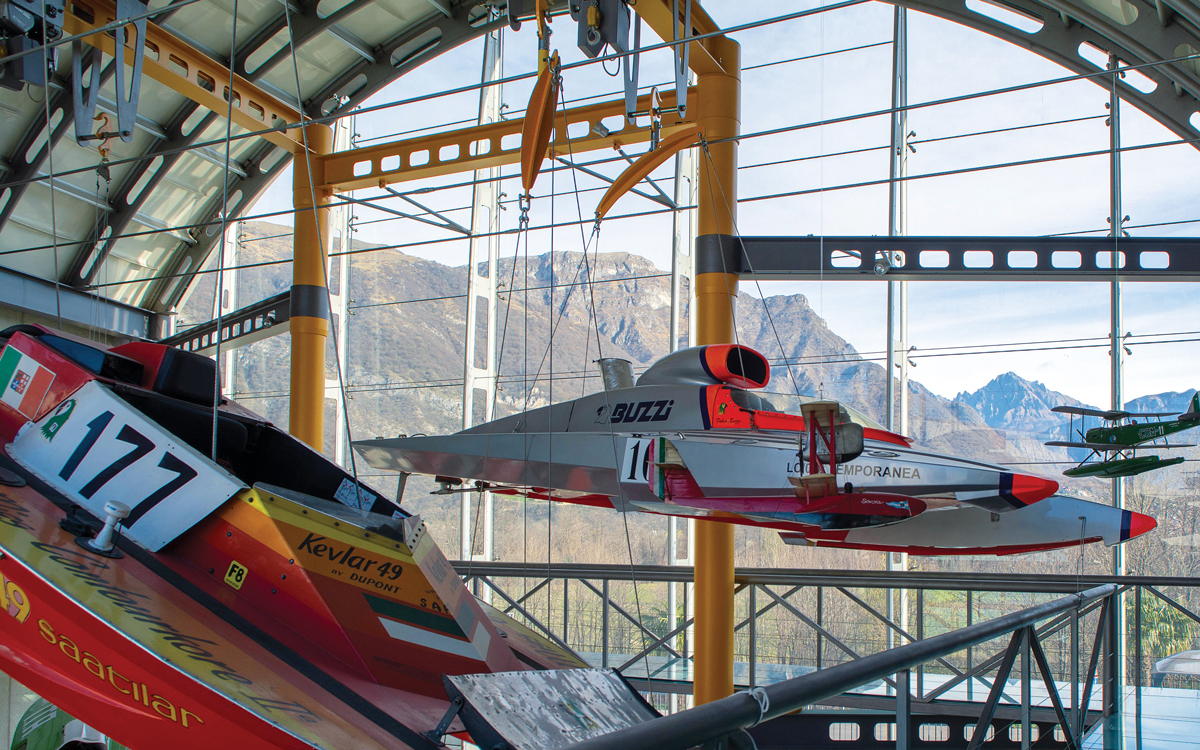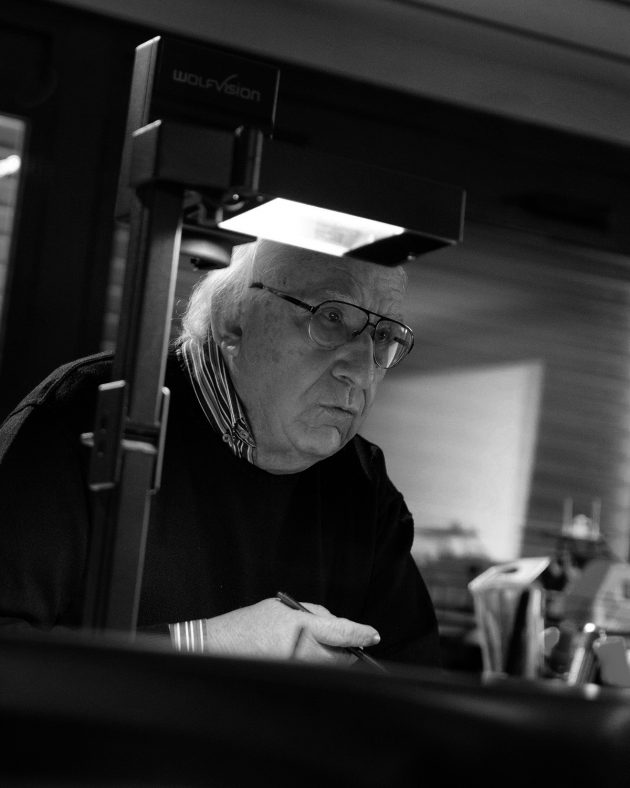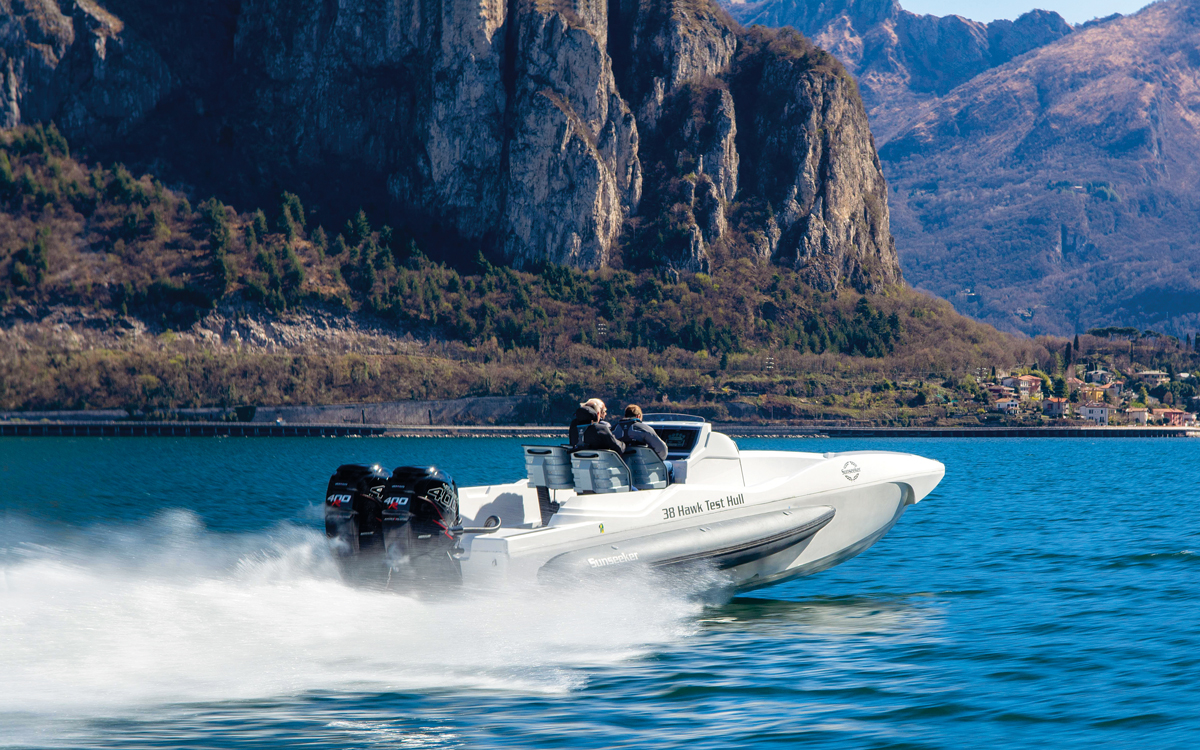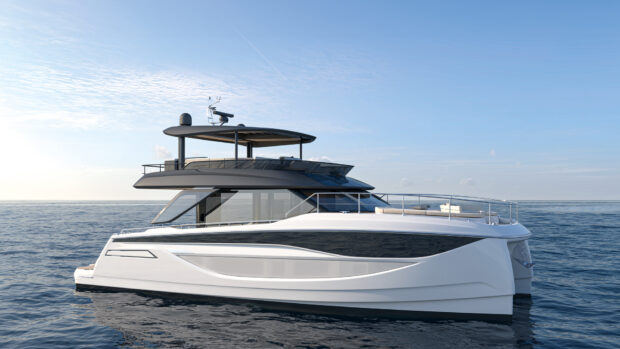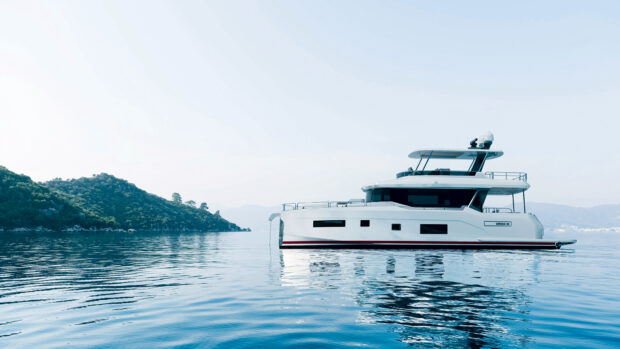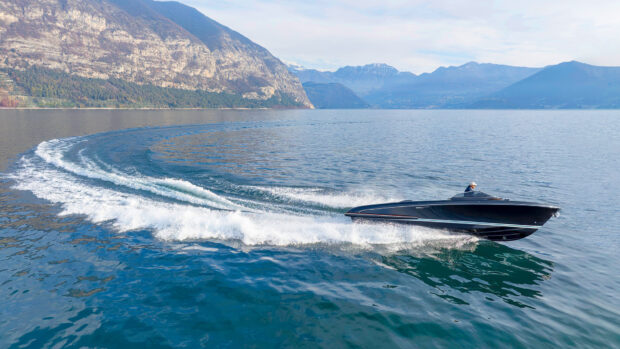In light of the tragic death of Fabio Buzzi, we wanted to remind people of what a remarkable person he was, as Hugo found out when he met him for an exclusive preview of the Sunseeker Hawk 38
What do Sunseeker, the SBS and parrots have in common? The answer is a 76-year-old Italian powerboat racer by the name of Fabio Buzzi.
At an age when most competitors have long since hung up their racing boots in favour of comfy slippers, Buzzi is not only setting new speed records (he broke the record for diesel powered boats last year), he’s also supplying patrol boats to 43 different military corps and designing and building the hull of Sunseeker’s new superboat – the Hawk 38.
Oh, and he’s obsessed with parrots. Really obsessed. His company logo is a parrot head and one entire office at FB Design’s factory near Lake Como in Italy is a giant aviary in which colourful parrots fly around, preening, squawking (in Italian of course) and landing on the finance manager’s desk.
Avian eccentricities aside, the man is also a powerboating legend with more accumulated experience of building and racing fast boats than any other person on the planet. From marathon offshore events to river racing in hydroplanes and everything in between, there is nothing the man hasn’t competed in. And won.
Cowes-Torquay-Cowes, Round Britain, Offshore Class 1, USA Superboat – the list goes on. Even the hand-picked collection of boats suspended from the ceiling outside his office includes everything from a tiny wooden outboard-powered single seater (his very first race boat) to the monstrous quad-engined Red FPT and a hydroplane powered by a gas turbine engine from a helicopter.
I could happily spend an entire week in Buzzi’s company listening to racing anecdotes and the intricacies of modern hull design but I’m here for a reason – to drive the Hawk 38, Sunseeker’s first true performance boat in more than a decade.
Article continues below…

VIDEO: Full-throttle test of the 60-knot Sunseeker Hawk 38

VIDEO: Princess R35 sea trial test
Technically this is still the prototype without any of the fixtures and fittings that will turn it from a quasi-race boat into a fully-fledged luxury superboat, but as far as the driving experience goes it’s the real deal.
With it’s long, slender triple-stepped hull, 24˚ deadrise and twin Mercury R400 outboard engines, it should perform and handle just like the finished boat, albeit without the extra tonne or so that the windscreen, hard top and fully plumbed heads compartment will add to it.
Even with these concessions to comfort, the Hawk 38 will still be a very different beast to that other hotly anticipated £500,000 British superboat, the Princess R35. Where the Princess is a luxurious, carbon fibre, foil assisted 50-knot weekender, the Sunseeker is a pure open high-speed day boat – a faster, more focused driver’s machine guaranteed to get you to the beach first, come hell or high water.
If it’s to deliver on that promise it needs to be not just a couple of knots quicker than its high-tech British cousin but in a different ball park altogether. There’s only one way to find out…
Mountain hideaway
If Fabio Buzzi’s factory is a tad quirky, wait until you see his secret test facility. Concealed behind locked gates and nestled into the mountainside on the shore of Lake Como, it’s based in a disused road tunnel, which Buzzi bought from the regional authorities.
Buzzi being Buzzi, it wasn’t enough that it already looked like a film set for The Italian Job, so he had the entire thing spray painted by a local graffiti artist with scenes of weird dystopian sea battles between the police and a motley assortment of drug smugglers, terrorists and other such ne’er-do-wells.
There is some logic to it given that the Guardia di Finanza, responsible for policing Italy’s vast coastline, is one of FB Design’s biggest customers, but somehow I can’t see Rodman, Halmatic or any other patrol boat manufacturer taking quite such a tongue-in-cheek approach to factory décor.
Still, given that we’re about to test a boat with an estimated top speed of more than 60 knots on a lake with an official speed limit of just 27 knots, it pays to stay in with the local police!
Jaw still scraping along the ground, I make my way down the metal staircase leading to the pontoon where the Hawk 38 prototype is waiting for us. Even in the plain white gelcoat with which it left the mould (owners will be able to pick from a selection of standard or optional painted finishes) and without any of the styling adornments specified by Sunseeker’s design department, it looks the business.
Long, low, lean and purposeful, it bears more than a passing resemblance to that other well-known Buzzi/Sunseeker collaboration the XS 2000. Although, technically the Hawk 38 uses a brand new hull from a brand new mould, Buzzi freely admits that it’s an updated and in his view ‘perfected’ version of the hull that underpinned both the XS and the FB 38 high-speed patrol boat.
But whereas the previous hull had two steps and was hand drawn and sculpted with the inevitable asymmetries and imperfections that entails, this latest variant was honed on FB Design’s computer-controlled five-axis milling machine to be 100% accurate.
Buzzi reckons it’s his best hull yet and while Sunseeker has exclusive rights to the leisure version and the freedom to design its own deck and helm console, FB Design retains the rights for its commercial craft.
Unlike the XS 2000, it also features Buzzi’s trademark STAB tubes, which not only provide much improved low-speed stability (at planing speed the tubes lift clear of the water) but also help cushion landings and maintain performance in the rough.
Buzzi likens the effect to a basketball; rather than landing with a thud and dissipating all its kinetic energy with sound and heat, it recovers most of it by bouncing back into the air. He claims his STAB boats do much the same thing, skipping across the wave tops rather than losing speed every time they crash back down again.
His lightbulb moment came during a race between a rigid-hulled FB 38 and an identical FB Tecno 40 RIB; on calm stretches the rigid-hulled boat was a knot or two faster but as soon as they hit choppy conditions the RIB version streaked ahead.
His solution was to fit much smaller STAB tubes at the stern, which combined the rough weather ability of the RIB with the speed, weight and size advantages of the rigid boat.
Reality strikes
Enough about the theory, time to test the reality. With Buzzi at the wheel and me sat alongside on one of the four matching Buzzi-designed suspension seats, he fires up the twin 400hp Mercurys (425hp Yamahas will be an option in some markets) and steers us away from the dock.
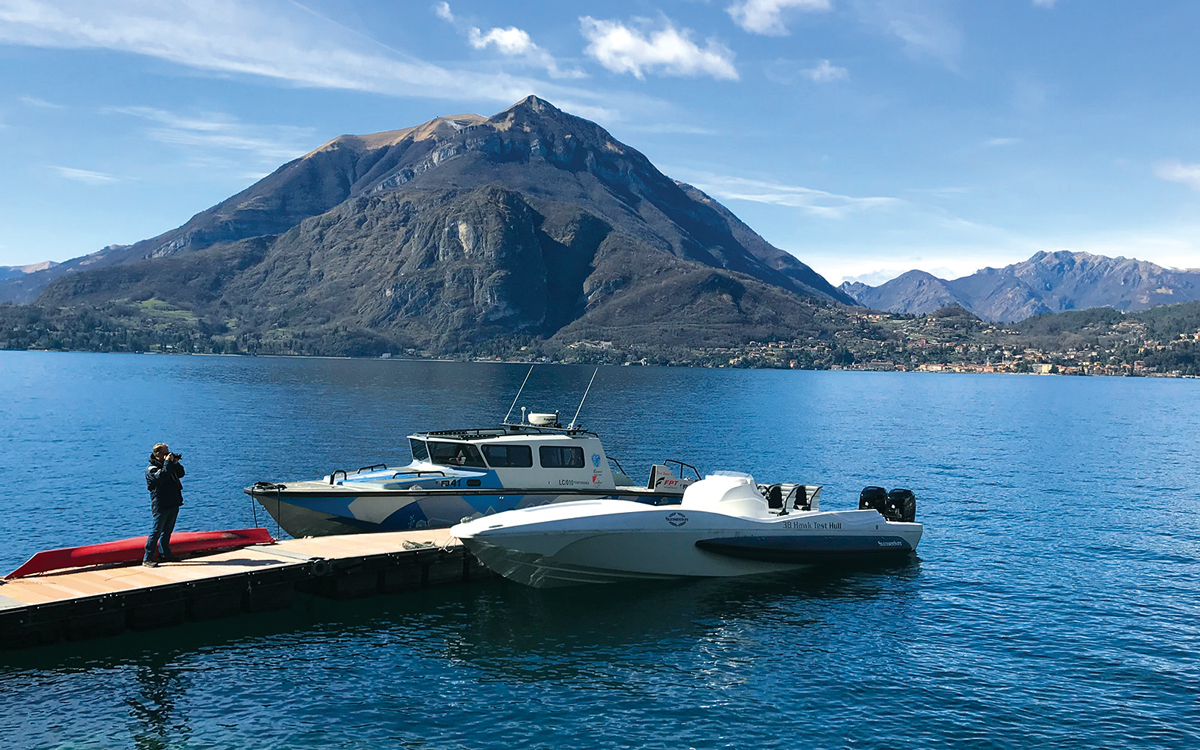
The prototype hull and deck of the Sunseeker Hawk 38 and the 60-knot FB Design patrol boat we used as a high-speed camera platform
Even by sportsboat standards the Hawk feels unnaturally thin (at 7ft 7in wide it’s 3ft narrower than a Princess R35 and almost half the width of a Sunseeker Predator 50). Although this benefits both its speed and rough weather ride, the real reason is more prosaic – it’s the widest it could be while still fitting into a standard shipping container for easy transportation to trouble spots and superyacht havens alike!
It’s also very low and exposed, almost disturbingly so without the windscreen, see-through side coamings and grab rails that will envelop the production boat’s occupants. My hands instinctively seek out something to hang onto as Buzzi starts to up the pace.
The acceleration is rapid and unrelenting, climbing onto the plane at around 12 knots and firing on past 20, 30 and 40 knots in roughly the time it takes to read this sentence. Buzzi pauses briefly at 50 knots to allow me to catch my breath. The wind is already whipping over the bare centre console, causing my eyes to water and tugging at what’s left of my hair.
The real surprise comes when he pushes the twin throttles the last few inches and I’m pinned into my seat once again. It accelerates from 50-60 knots as hard as most sportsboats do from 30-40, and even above 60 knots the speed-over-ground readout keeps on marching upwards.
At 65 knots there’s another pause while Buzzi trims out the legs to ensure the hull is skimming across the surface with just the trailing edge of the steps still kissing the water. My eyes are now taking such a buffeting from the wind that I can feel my eyeballs distorting, throwing my vision out of focus. Only by ducking below the lip of the console can I finally get a sharp enough glimpse of the MFD’s speed reading: 68.6 knots!
I grab a quick snap on my phone and hurriedly stuff it back into my pocket so I can regain my grip on the seat. Buzzi is heading for the wake of the patrol boat, which we are using as a photo boat, and showing no signs of slowing down.
With a good 20ft of bow in front of us and those triple steps ensuring a very flat running angle, I’ve no idea how this is going to end. The impact, when it comes, is rather a non-event. The bow barely deviates from its bullet-like trajectory, nodding briefly as it crests the wake then settling straight back down to carry on carving across the surface as true and straight as an ice-skater’s blade.
Drive time
After a couple more passes to check everything is as it should be, Buzzi relinquishes the helm and invites me to take his place. The driving position feels good but needs an extra step to support your feet when seated. The steering also needs speeding up, as the seven turns lock to lock is way too slow for such a rapid machine. Both are already on the snagging list for sorting prior to production.
Separate throttles and gears are standard fare on most high performance boats but these electronic shifters with shorter levers for the gears and longer ones for the throttles are lighter, smoother and easier to get to grips with. The debate continues about whether to fit trim tabs. Buzzi is confident it doesn’t need them and on a lake as flat as this it doesn’t, but on a windswept Solent they might still come in handy.
Perhaps the most surprising thing about the Hawk 38 is how easily you get accustomed to its speed. That’s partly down to the hull’s arrow-straight tracking and the easy accessibility of the engine’s performance, but it’s also encouraged by the sheer refinement of the whole package.
Buzzi’s patented structural foam build process ensures that the normal voids between hull and deck are injected with expanding foam. Once set solid this forms a structural bond that not only increases the structural rigidity but also dampens noise transmission and makes the whole craft unsinkable.
The result is a very stiff, quiet hull that when combined with the smooth supercharged outboard engines makes for an extraordinarily civilised high-speed craft.
Race bred
This isn’t yet the finished package and it will be interesting to see how it copes in the more challenging conditions of a Solent chop or Mediterranean swell, but the signs are encouraging to say the least.
Some have criticised Sunseeker for outsourcing the design and build of the hull to FB Design before shipping it to the UK for fitting out at Superyacht Services in Lymington (there is no room for it at the factory in Poole), but I take a different view.
Why spend a fortune trying to match the speed and strength of a Buzzi boat when you can buy all his accumulated experience then design the finished boat to look and feel like a Sunseeker.
After all, as a pure open sports boat, there is still room above it for a larger British-built Superhawk [ed. At the Cannes Boat Show earlier this month, Sunseeker confirmed it will launch a Superhawk 65 in 2021].
Far better to celebrate the Hawk 38 for what it is – a focused and enjoyable day boat that puts Sunseeker back on the performance map. Just don’t be surprised if the invoice comes with a parrot feather stuck to it!
First published in the June 2019 edition of Motor Boat & Yachting.







